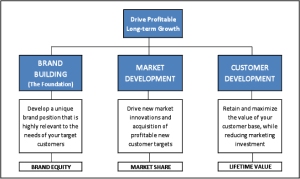7 Truths About Branding
May 29, 2014 § Leave a comment
Lessons learned in the trenches as a senior brand strategist.
I have directed/lead countless branding initiatives for my clients over the past 25 plus years that have confronted complex business challenges such as acquisitions; market entry; global expansion; new products, audiences and channels; repositioning; brand revitalization; and integrated digital and traditional media communications. While I have been fortunate to see the majority of these projects result in double-digit increases in sales, profitability and brand equity, not all of them have been as successful. This article summarizes the top 7 truths I have learned through all of my experiences, including the good, the bad and the ugly projects. It is my sincere hope that you as a business leader or marketing professional can apply these learnings to improve your own business outcomes and avoid some of the pitfalls that plague traditional business thinking today.
- Ignore the real issues at your own peril.
This sounds simple enough, but in reality procrastination can happen even in the C-suite. For example, when sales erosion issues occur, there is a tendency to react quickly. Promotions or discounting are often implemented tactically to stop the bleeding, but it ends there. The heart of the issue remains unresolved due to competing priorities, limited resources or a host of other distractions. Overtime, ignoring the real issues erodes brand value, followed by shrinking margins and market share.
Think of brand value as an equation: “Brand Value = (Product Benefits + Service Benefits + Channel Benefits + Brand Equity) – Costs.” [i] Brands with the highest perceived brand value usually win in their categories. This requires a holistic evaluation of the brand value equation to develop strategies that leverage the combined strengths of all five elements. Maximizing brand value in turn drives consumer choice leading to sustainable competitive advantage and profitable growth.
- Storydoing brands outperform storytelling brands.
All the hype lately has been about storytelling. However, it is a proven fact that storydoing companies that place strong emphasis on “living their brands” outperform storytelling brands that merely “tell their brand stories” (via marketing communications).[ii] This is largely true across all sectors, but I think it is especially important in retail, healthcare and service-related industries where frontline  employees are the face of the brand. Organizations that have inculcated their brand promise and core values deeply into the fabric of their culture and have empowered their employees to deliver “authentic, branded service encounters” always stay on top. Think Zappos, Mayo Clinic and Southwest Airlines as examples. But there are no magic bullets. Storydoing requires continual focus, hard work and sometimes foregoing short-term profit gains to achieve sustainable competitive advantage and future ROI.
employees are the face of the brand. Organizations that have inculcated their brand promise and core values deeply into the fabric of their culture and have empowered their employees to deliver “authentic, branded service encounters” always stay on top. Think Zappos, Mayo Clinic and Southwest Airlines as examples. But there are no magic bullets. Storydoing requires continual focus, hard work and sometimes foregoing short-term profit gains to achieve sustainable competitive advantage and future ROI.
- Brand irrelevancy is today’s biggest business challenge.
These days, disruption happens at lightning speed. Companies must continually reinvent themselves or risk brand irrelevancy. But, most organizations are either unaware of the looming signs that their business models are under siege or, unfortunately, underestimate the magnitude. Digital disruption can drive dramatic changes in market dynamics, such as the emergence of new categories/subcategories that raise the bar on consumer preferences, as well as create an onslaught of new, non-traditional competitors. It has been estimated that companies are now forced to redefine their business models about every six years on average or  face brand irrelevancy. The problem is exacerbated by the fact that many organizations do not see it coming until it’s too late. Or they are unable to confront these formidable realties with forward-looking, game-changing strategies. Brand irrelevancy occurs when consumers choose a target category or subcategory to buy and a particular brand (even if it was once the category leader) has slipped from the consideration set, resulting in shrinking margins and market share.[iii]
face brand irrelevancy. The problem is exacerbated by the fact that many organizations do not see it coming until it’s too late. Or they are unable to confront these formidable realties with forward-looking, game-changing strategies. Brand irrelevancy occurs when consumers choose a target category or subcategory to buy and a particular brand (even if it was once the category leader) has slipped from the consideration set, resulting in shrinking margins and market share.[iii]
- Incremental innovation does not create sustainable competitive advantage.
While ongoing lean process improvement and incremental enhancements made to the offering are important, today’s market realities often dictate the need for transformational change. But antiquated organization structures, silo thinking, traditional mindsets and fierce P&L pressure to defend a brand’s existing turf are among the chief barriers that prevent business model reinvention. Many corporate leaders choose to take the easy path by making incremental enhancements to their core competencies instead of driving category-changing transformation. They argue that it is better to “stick to our knitting,” “keep our focus,” “avoid diluting our energies. However, traditional thinking such as this can be dangerously short-sighted in today’s dynamic and volatile business climate. David A. Aaker in his book titled Brand Relevance argues that creating a new category/subcategory can result in a first-mover advantage and the potential of earning significant ROI because, with little or no competition, margins can be very attractive. Tenure of this marketing position then  depends on the barriers the firm creates, including customer loyalty, an image of authenticity, scale economies, preemptive strategies and competitor inhibitions to name a few. Companies like Google, Best Buy and Zipcar have won the brand relevance battle by boldly creating breakthrough offerings that form new categories/subcategories, and have effectively managed them to become the undisputed exemplars. But this takes vision, courage, relentless focus and a willingness to explore blue ocean opportunities that may even extend beyond an organization’s core competencies.
depends on the barriers the firm creates, including customer loyalty, an image of authenticity, scale economies, preemptive strategies and competitor inhibitions to name a few. Companies like Google, Best Buy and Zipcar have won the brand relevance battle by boldly creating breakthrough offerings that form new categories/subcategories, and have effectively managed them to become the undisputed exemplars. But this takes vision, courage, relentless focus and a willingness to explore blue ocean opportunities that may even extend beyond an organization’s core competencies.
- Brand Equity is your best offensive strategy when transformational business innovation isn’t an option.
A second strategy for creating or maintaining brand relevance is to look beyond the offering and focus on specific brand equity attributes that strengthen the emotional connection that consumers have with your brand and make it unique from all others. Frankly, for companies in many types of service industries or in highly commoditized business segments where it is easy for competitors to copy the features of your offering, this becomes the only sensible strategy that can be pursued to create competitive advantage. According to David A. Aaker, this makes competitors irrelevant because they lack these “essential” elements. Brand equity attributes that build trust and/or deliver powerful self-expressive benefits can include:
- Shared interests that are as meaningful to customers as the offering itself (e.g., Pampers, which has positioned its brand’s category
 to be associated with baby care as well as being a disposable diaper brand)
to be associated with baby care as well as being a disposable diaper brand) - A distinctive and enduring brand personality (e.g., Asahi Super Dry, which has a western, young and modern personality that contrasts sharply to its archrival, Kirin, which is the classic “your father’s brand”
- Organization values and culture, such as innovation (3M), customer-driven (Nordstrom’s), quality-driven (Cadillac) and concern for the environment (Toyota Prius)
- Passion (e.g., Apple because of its passion for design and commitment to delivering innovation and an over-the-top user experience)
- Social programs (e.g., The Body Shop through its visible endorsement of third-world ecology and workforces and Lay’s SunChips through its visible use of solar power and compostable packaging)[iv]
- Three-way communication and relationship building is the name of the game.
A lot has been written lately about the power of big data. The fact is that most companies have a plethora of data points available to them. What’s missing most often (especially among small and midsize businesses) is an essential IT infrastructure required to command a 360 degree view of the available data via all channels and customer touchpoints, as well as the expertise needed to glean rich consumer insights from all that data. Additionally, many companies are challenged to keep up with the rapidly evolving media landscape and find the ideal media mix. This is because the market is constantly being redefined by emerging digital media technologies, yet traditional media still dominates in most industries. Furthermore, optimizing the full potential that each channel has to offer and delivering a unified customer experience across all of them creates yet a new set of challenges. Winning the battle for customer attention and loyalty today requires investing in the right tools and skill sets to develop new, consumer-centric strategies to drive meaningful three-way communication and relationship-building initiatives (i.e., brand-to-consumer, consumer-to-brand, and consumer-to-consumer). Sadly, most marketing organizations still approach communications with a traditional mindset focused on selling rather than relationship building. While metrics and KPIs associated with acquisition are still important when measuring marketing ROI, increased weight must also be placed on measures focused on retention, loyalty, advocacy and brand equity.
- High visibility by the top leader is the most essential requirement.
 A Harvard Business School research team recently conducted a study of the top B2B global brands and found that they shared a common characteristic: The CEO was a highly visible brand cheerleader and storyteller and understood the benefits of a great brand. In short, the top leader of the organization must view branding as a crucial business strategy for driving increased ROI, as well as long-term growth and brand equity. And without strong leadership endorsement and visibility, I have learned that it is futile to attempt a rebranding project or other multifaceted branding initiative that requires cross-departmental cooperation, buy-in and behavioral change.
A Harvard Business School research team recently conducted a study of the top B2B global brands and found that they shared a common characteristic: The CEO was a highly visible brand cheerleader and storyteller and understood the benefits of a great brand. In short, the top leader of the organization must view branding as a crucial business strategy for driving increased ROI, as well as long-term growth and brand equity. And without strong leadership endorsement and visibility, I have learned that it is futile to attempt a rebranding project or other multifaceted branding initiative that requires cross-departmental cooperation, buy-in and behavioral change.
Endnotes:
[i] Value Creation: The Power of Brand Equity, by William Neal and Ron Strauss, published by SOUTH-WESTERN CENGAGE Learning, copyright © 2008 by Texere, page 127
[ii] Storydoing™ (http://storydoing.com), managed by co:collective, copyright ©2013
[iii] Brand Relevance – Making Competitors Irrelevant, David A. Aaker, published by Jossey-Bass, copyright © 2011 by John Wiley & Sons, First Edition, page 297
[iv] Ditto iii, page 315
The Relationship between Online Customer Reviews and Brand Equity
March 3, 2014 § Leave a comment
Products with low brand equity require different strategies than products with high brand equity.
A recent study showed that encouraging customers with positive experiences to post online reviews can be a powerful strategy for driving customer acquisition. However, such a strategy may not be equally effective for all products. For products with low brand equity, such as new or emerging brands, there is a significant correlation between cumulative online customer reviews (positive or negative) and sales impact. But for products with high brand equity, such as category leaders and well-established brands, cumulative online customer reviews (positive and negative) do not have a significant effect on sales. The study concluded that different strategies are needed for each group.[i]
Low Brand Equity Products
A proactive strategy should be adopted that focuses on generating positive online reviews for product models with low brand equity. This is because they can benefit sales of that particular model directly as well as strengthen equity for the brand overall. This can enable weaker brands to compete more successfully against stronger brands by “flipping the funnel” (Spending less on traditional advertising and more effort on increasing satisfaction and loyalty to drive word of mouth and customer acquisition).
An essential requirement for this strategy to succeed, of course, is a truly superior product offering. One that is relevant, differentiating and, ideally, has the potential to become a category changer. Tactics that can be used to encourage positive online customer reviews include:
- Make detailed information about products available and easily accessible online.
- Establish brand communities and early adopter clubs. Members of these clubs can buy products with incentives before launch to spark the feedback process. Management can also use positive feedback as seeds and negative feedback to modify and improve their products before launch.
- Provide samples to expert review websites. (Anecdotal evidence suggests that customers often refer to expert reviews in their own reviews.)
- Send reminders and incentives to customers to encourage posting reviews.
High Brand Equity Products
Product models with high brand equity, however, have little to gain by pursuing a concentrated strategy designed to garner and leverage positive online customer reviews. That said, “These products models still receive a significant sales boost from being part of a strong brand; therefore, their resistance to positive reviews does not disadvantage them and they are protected to a degree from negative review.”[ii] And, although models of a strong brand are not affected directly by their own online customer reviews, they can be adversely affected by positive customer reviews for models of weak brands, allowing these competitors to draw consumers away from them. Furthermore, while controlling negative online customer reviews may not be as important for strong brands, brand managers are well advised to monitor them and take corrective actions. This is because the cumulative body of negative reviews overtime can become increasingly important if these brands lose category relevance and strength.[iii]
So, to avoid risk of losing category relevance, strong brands have more to gain by being vigilant in their efforts to create barriers to competition instead of on generating online customer reviews. Two leading strategies to consider include:
- Invest to create superior product models that leapfrog the competition by improving performance around common features, adding new features or eliminating major limitations. Such a leapfrog strategy can dramatically reduce incidences of positive online customer reviews on product models of weaker brands and essentially make these competitors irrelevant.
- Create energy through branded sponsorships (e.g., Valvoline motor oil and its NASCAR sponsorship) or branded social programs (e.g., Avon Walk for Cancer). Brand energizers, such as these, can dramatically strengthen brand loyalty and negate the impact of positive reviews on product models of weaker brands.
Summary
Brand equity plays a significant role in moderating the relationship between online customer reviews and sales. Products with low brand equity have much to gain by directly pursuing strategies to capture and leverage positive online customer reviews. While products with high brand equity have more to gain by being on the offensive and continually raising the bar through innovation or creating brand energy to strengthen customer loyalty and reduce the impact of positive reviews on competitors’ products.
Today’s Biggest Business Challenge
February 11, 2014 § Leave a comment
These days, disruption happens at lightning speed. Companies must continually reinvent themselves or risk brand irrelevancy – the biggest problem facing most businesses today.
The simple truth is that most organizations are either unaware of the looming signs that their business models are under siege or, unfortunately, underestimate the magnitude. Digital disruption can drive dramatic changes in market dynamics, such as the emergence of new categories/subcategories that raise the bar on consumer preferences, as well as the onslaught of new and non-traditional competitors. It has been estimated that companies are now forced to redefine their business models about every six years on average or face brand irrelevancy.
The problem is exacerbated by the fact that many organizations do not see it coming until it’s too late. Or, they are unable to confront these formidable realties with forward-looking, game-changing strategies. Brand irrelevancy occurs when consumers choose a target category or subcategory to buy and a particular brand (even if it was once the category leader) has slipped from the consideration set, resulting in shrinking margins and market share.
Antiquated organization structures, silo thinking, traditional mindsets and fierce P&L pressure to defend existing turf are among the chief barriers that prevent business model reinvention. Many corporate leaders choose to take the easy path by making incremental enhancements to their core competencies instead of driving category-changing transformation. They argue that it is better to “stick to our knitting,” “keep our focus,” “avoid diluting our energies. However, traditional thinking such as this can be riskier today!
So how do organizations create/renew brand relevance in today’s volatile business climate?
Transformational Innovation
 One strategy, according to David Akker in his book titled Brand Relevance, is to create transformational offerings that form new categories/subcategories and make the competition irrelevant. He argues that creating a new category/subcategory can result in a first-mover advantage and the potential of earning significant ROI because, with little or no competition, margins can be very attractive. Tenure of this marketing position depends on the barriers the firm creates, including customer loyalty, an image of authenticity, scale economies, preemptive strategies and competitor inhibitions to name a few.
One strategy, according to David Akker in his book titled Brand Relevance, is to create transformational offerings that form new categories/subcategories and make the competition irrelevant. He argues that creating a new category/subcategory can result in a first-mover advantage and the potential of earning significant ROI because, with little or no competition, margins can be very attractive. Tenure of this marketing position depends on the barriers the firm creates, including customer loyalty, an image of authenticity, scale economies, preemptive strategies and competitor inhibitions to name a few.
Akker’s book, which I highly recommend reading, provides a powerful framework for finding new concepts, picking the winners, defining and managing new categories/subcategories, and creating barriers to ensure sustainable differentiation. It also offers an array of in-depth case studies on companies, such as Best Buy, Toyota, Zipcar and Apple. These companies have won the brand relevance battle by boldly creating breakthrough offerings that form new categories/subcategories, and effectively managing them to become the undisputed exemplars.
Brand Equity
A second strategy for creating or maintaining brand relevance is to look beyond the offering and focus on specific brand equity attributes that make your brand unique from all others and drive consumer choice. Frankly, for companies in many types of service industries or in highly commoditized business segments where it is easy for competitors to copy the features of your offering, this is the only sensible strategy that can be pursued to drive sustainable competitive advantage. This can make competitors irrelevant because they lack these “essential” elements.
Brand equity attributes that build trust and/or deliver powerful self-expressive benefits include:
- Shared interests that are as meaningful to customers as the offering itself (e.g., Pampers, which has positioned its brand’s category to be associated with baby care as well as being a disposable diaper brand)
- A distinctive and enduring brand personality (e.g., Asahi Super Dry, which has a western, young and modern personality that contrasts sharply to its archrival, Kirin, which is the classic “your father’s brand”
- Organization values and culture, such as innovation (3M), customer-driven (Nordstrom’s), quality-driven (Cadillac) and concern for the environment (Toyota Prius)
- Passion (e.g., Apple because of its passion for design and commitment to delivering innovation and an over-the-top user experience)
- Social programs (e.g., The Body Shop through its visible endorsement of third-world ecology and workforces and Lay’s SunChips through its visible use of solar power and compostable packaging)
Brand Differentiation is the Starting Point for Driving Profitable Long-term Growth
May 8, 2012 § Leave a comment
Without a differentiated brand positioning, organizations face commoditization, and it becomes exceedingly challenging to win new customers except when competing on price.
Quad/Graphics’ third annual Special Interest Publishers Survey revealed many key insights about publishers’ pain points, needs and strategic priorities. While the findings were unique to magazine publishing, they were consistent with recent studies conducted with C-level executives in other industries, such as the retail trade, consumer packaged goods, insurance/financial/education/healthcare services and associations/not-for-profit. They all center on a singular strategic imperative: to drive profitable long-term growth.
At the end of the day, the ability to successfully carry out this mission is largely dependent on an organization’s performance in three critical areas referred to in my earlier posts as the “Three Pillars of Marketing”:
- Brand Development – driving profitable growth through a brand positioning that is unique from market alternatives and relevant to customer needs;
- Market Development – driving acquisition of profitable new customer targets to grow market share and expand into new markets; and
- Customer Development – retaining and maximizing the value of existing customers while reducing marketing investment and costs to serve them.
Developing a differentiated brand positioning is the first step. This is the foundation that drives everything that happens in the remaining two pillars. Without it, organizations face commoditization, and it becomes exceedingly challenging to win new customers except when competing on price.
Unfortunately, when growth stalls branding is often overlooked in favor of short-term tactics, such as price-cutting or promotions designed to boost sales. But the real issues – lack of differentiation and relevance as customers’ needs change – often fail to be acknowledged and appropriately addressed.
One reason busy executives tend to overlook branding as a strategic business tool is that the concept of brand is misunderstood. They think of a brand simply as a logo, tagline or ad campaign. They fail to understand its deeper meaning and that branding is a multistep journey: the one tool in their tool chest that can have the greatest impact on growing the long-term profitability and asset value of their business.
For many organizations, brand equity is the most valuable asset that appears on the balance sheet. And strategic branding lays the foundation for increasing the return on your overall marketing dollar investment and other closely related benefits, such as category leadership, reduced vulnerability to competition, the ability to charge premium prices and quicker acceptance of new products and services.


